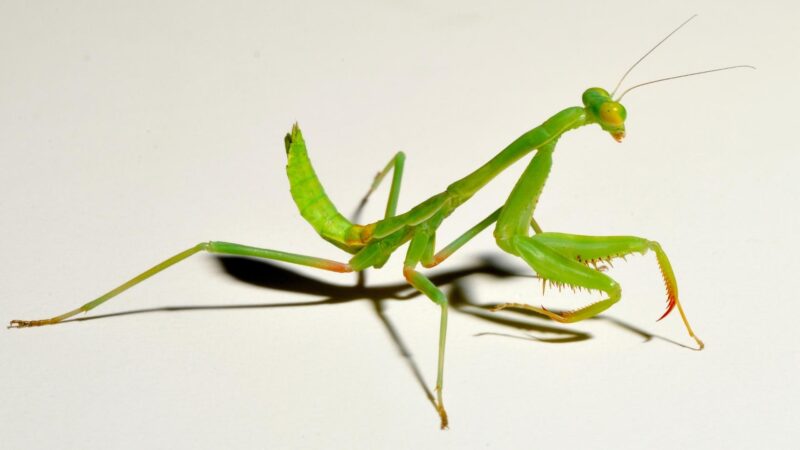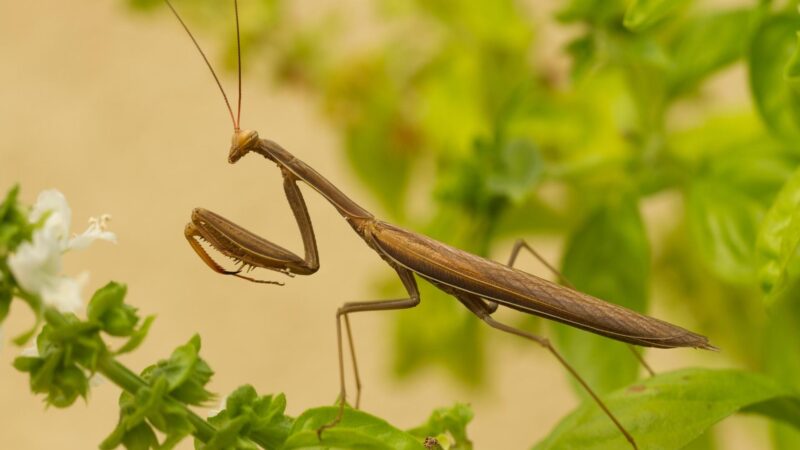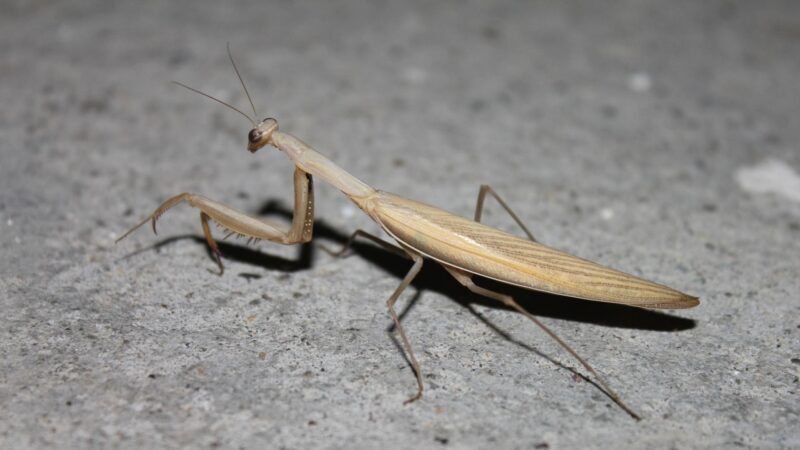The praying mantis is a very fascinating insect but is sometimes misunderstood. Aside from having a unique appearance, it is the only insect in the world that can turn its head for a whopping 180-degree angle (side by side) without moving its body! Interestingly, their saintly image is the opposite of their true character.
Praying mantises are not listed as endangered species. Although some species are rare, there are a lot of other species that can be seen almost anywhere around the world. Contrary to a popular myth, no law prohibits people from killing them. It is not a good idea, though.
The name “mantis” came from the Greek word, which means “prophet.” Although the European mantis species is not native to Connecticut, it has been the Official State Insect since October 1, 1977. In this article, you will learn more interesting facts about praying mantises, including whether they are truly beneficial or not.
Table of Contents
What Is a Praying Mantis?

Technically, praying mantis is the common name for insects that have an upright posture and appear to be kneeling and praying while waiting for their prey. These slow-moving ambush predators can be identified through their compound eyes, elongated bodies, triangular heads, and unique raptorial front legs.
Many people use the terms “mantis” and “mantids” interchangeably. But then, mantises belong to the family Mantidae, which is part of the entire insect group called Mantid. Mantises are often confused with stick insects, which are in the order of Phasmatodea. The closest relatives of mantises are roaches and termites.
How Many Species of Praying Mantis Are There?
There are more than 1,500 praying mantis species worldwide but only around 20 of them are found in North America. This includes the Carolina mantis (Stagmomantis Carolina), Arizona mantis (Stagmomantis limbata), Chinese mantis (Tenodera aridifolia), and the European mantis (Mantis religiosa).
What Is the Rarest Praying Mantis?
There has been a huge debate about the rarest praying mantis and there is no solid answer. So far, the moss mantis (Pogonogaster tristani) is one of the rarest praying mantises. But back in August 2012, photographer Oscar Blanco found a nymph of this well-camouflaged praying mantis in the mountains in Costa Rica.
Meanwhile, another rare praying mantis species is the Brazilian dragon mantis (Stenophylla cornigera). As the name implies, this praying mantis is native to Brazil. Although their exact number remains unknown, this insect species is usually found only in museums. In 2017, two of them were found in Atlantic Forest.
Where Do Praying Mantis Live?

Praying mantises live in tropical and subtropical areas. They are commonly found in deserts, farms, gardens, grasslands, meadowlands, and rain forests. Aside from North America, these stealthy predators are also widely distributed across Asia, Southern Europe, and Southern Africa. Some species are also found in Australia.
Is Praying Mantis on the Endangered Species List?
The praying mantis is not an endangered species and is not protected by law, especially in the United States. This is contrary to the rumor that started in the 1950s, wherein killing kneeling insects is said to be immoral. Since praying mantises eat various garden pest insects, people also thought that killing them is illegal.
Is Praying Mantis Illegal to Keep?

Praying mantises are not illegal to keep. So far, no law bans people from keeping them as pets. However, it does not necessarily mean you can go to the forest and catch them. Instead, buy a praying mantis online or from a reptile pet store. Nevertheless, make sure you can feed and take care of them properly.
On the other hand, some gardeners prefer buying praying mantises instead of pesticides to protect their plants from insect pests. But although praying mantises are considered beneficial insects, they also eat each other. Species native to other countries may also not adapt themselves easily to their new surroundings.
Can Praying Mantis Live In Captivity?
Praying mantises can live in captivity. But unlike cats and dogs, they should be kept in a terrarium with enough space. Otherwise, they will fly away and escape. To avoid cannibalism, house them individually and allow them to climb in twigs. You should also feed them with live insects such as fruit flies and moths.
What Is the Lifespan of a Praying Mantis?
In captivity, praying mantises have a lifespan of 12 to 18 months if properly taken care of. Aside from food and water, they also need the right temperature, which depends on the species. In the wild, praying mantises can only live from six months to one year. Nonetheless, their average lifespan is only 10-12 months.
Praying mantises undergo incomplete metamorphosis, which means they only have three life stages – egg, nymph, and adult. They usually mate in the fall, and females lay egg masses that survive in the winter. Nymphs look like adults, except that they are smaller and wingless. There is only one generation per year.
Is Praying Mantis a Threat?

Praying mantises are not a threat. They don’t carry infectious diseases and are not harmful to humans. Despite being carnivores, these insect predators don’t sting humans and their prey. Praying mantises may bite humans, but it would be unintentional or as self-defense when they are threatened or mishandled.
Praying mantises eat live insects and are not destructive creatures. These alien-looking insects do not eat plants, flowers, fruits, and leaves. They also do not cause damage to wood and personal belongings. However, a report confirmed that some species are a threat to small birds, particularly hummingbirds.
Is Praying Mantis Poisonous to Humans?
When we say poisonous, it means that poison can get inside the body when a substance is swallowed, inhaled, or injected. Since praying mantises don’t have venom, their bite is not poisonous. Surprisingly, these generalist insects are edible and can be fried over an open fire. Praying mantises taste like shrimp.
Related: Are Brown Praying Mantis Poisonous? | Important Facts
Should You Kill a Praying Mantis?
You should not kill a praying mantis. As mentioned earlier, praying mantises are beneficial to the garden because they have an enormous appetite for pest insects. But since they are indiscriminate predators, praying mantises also eat pollinating insects such as bees and wasps, which help in plant reproduction.
Yet, being a pest rather than a beneficial insect should still not be a reason to kill a praying mantis. And although killing them is not illegal, it is still a cruel act. So, if you spot a praying mantis in your garden and it is not troublesome, let it live peacefully. Otherwise, repel the insect using soapy water or simply relocate it.
What Animal Eats a Praying Mantis?
Despite being vicious predators of insects, praying mantises are also prey. Among their natural enemies are bats, birds, frogs, lizards, spiders, and snakes. To avoid predators, they change their color to match their surroundings. Nymph praying mantises also tend to eat their siblings when there is a food shortage.
Meanwhile, sexual cannibalism is known in praying mantises. But while this weird behavior is true, it usually happens only in captivity. And although females eat the heads of their male partner during or after mating, a 2021 study suggested that some male praying mantises may also attack females to avoid being eaten.
Praying mantises play a vital role in our ecosystem. For a lot of farmers and gardeners, these masters of disguise can be more of a friend than a foe. As pets, these athletic insects are gentle and docile with their owners. But again, they are not entirely beneficial insects. If you think killing them is the last resort, so be it.
List of Sources
Male Coercion and Female Injury in a Sexually Cannibalistic Mantis